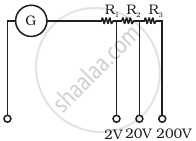Advertisements
Advertisements
प्रश्न
State the principle of the working of a moving coil galvanometer, giving its labeled diagram ?
उत्तर
Moving coil Galvanometer
Principle:
Its working is based on the fact that when a current carrying coil is placed in a magnetic field, it experiences a torque.

Working:
Suppose the coil PQRS is suspended freely in the magnetic field.
Let
l = Length PQ or RS of the coil
b = Breadth QR or SP of the coil
n = Number of turns in the coil
Area of each turn of the coil, A = l × b
Let B = Strength of the magnetic field in which coil is suspended
I = Current passing through the coil in the direction PQRS
Let, at any instant, α be the angle which the normal drawn on the plane of the coil makes with the direction of magnetic field.
The rectangular coil carrying current when placed in the magnetic field experiences a torque whose magnitude is given by,
τ = nIBA sin α
APPEARS IN
संबंधित प्रश्न
The combined resistance of a galvanometer of resistance 500Ω and its shunt is 21Ω. Calculate the value of shunt.
The fraction of the total current passing through the galvanometer is ............ .
a) `S/(S+G)`
b) `G/(S+G)`
c) `(S+G)/G`
d) `(S+G)/S`
Can a galvanometer as such be used for measuring the current? Explain.
Why does a galvanometer when connected in series with a capacitor show a momentary deflection, when it is being charged or discharged?
How does this observation lead to modifying the Ampere's circuital law?
Hence write the generalised expression of Ampere's law.
In the meter bridge experiment, balance point was observed at J with AJ = l.
(i) The values of R and X were doubled and then interchanged. What would be the new position of balance point?
(ii) If the galvanometer and battery are interchanged at the balance position, how will the alance point get affected?

A coil of radius 10 cm and resistance 40 Ω has 1000 turns. It is placed with its plane vertical and its axis parallel to the magnetic meridian. The coil is connected to a galvanometer and is rotated about the vertical diameter through an angle of 180°. Find the charge which flows through the galvanometer if the horizontal component of the earth's magnetic field is BH = 3.0 × 10−5 T.
The conversion of a moving coil galvanometer into a voltmeter is done by ______.
Assertion (A): On Increasing the current sensitivity of a galvanometer by increasing the number of turns may not necessarily increase its voltage sensitivity.
Reason (R): The resistance of the coil of the galvanometer increases on increasing the number of turns.
Select the most appropriate answer from the options given below:
A multirange voltmeter can be constructed by using a galvanometer circuit as shown in figure. We want to construct a voltmeter that can measure 2V, 20V and 200V using a galvanometer of resistance 10Ω and that produces maximum deflection for current of 1 mA. Find R1, R2 and R3 that have to be used.

